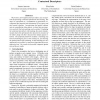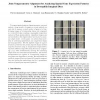CVPR
2005
IEEE
15 years 3 months ago
2005
IEEE
We present a new method for matching line segments between two uncalibrated wide-baseline images. Most current techniques for wide-baseline matching are based on viewpoint invaria...
CVPR
2005
IEEE
15 years 3 months ago
2005
IEEE
In many automatic face recognition applications, a set of a person's face images is available rather than a single image. In this paper, we describe a novel method for face r...
CVPR
2005
IEEE
15 years 3 months ago
2005
IEEE
Training datasets for learning of object categories are often contaminated or imperfect. We explore an approach to automatically identify examples that are noisy or troublesome fo...
CVPR
2005
IEEE
15 years 3 months ago
2005
IEEE
We address the problem of segmenting 3D scan data into objects or object classes. Our segmentation framework is based on a subclass of Markov Random Fields (MRFs) which support ef...
CVPR
2005
IEEE
15 years 3 months ago
2005
IEEE
CVPR
2005
IEEE
15 years 3 months ago
2005
IEEE
We present a novel approach for fast object class recognition incorporating contextual information into boosting. The object is represented as a constellation of generalized corre...
CVPR
2005
IEEE
15 years 3 months ago
2005
IEEE
We develop an object classification method that can learn a novel class from a single training example. In this method, experience with already learned classes is used to facilita...
CVPR
2005
IEEE
15 years 3 months ago
2005
IEEE
To compare spatial patterns of gene expression, one must analyze a large number of images as current methods are only able to measure a small number of genes at a time. Bringing i...
CVPR
2005
IEEE
15 years 3 months ago
2005
IEEE
CVPR
2005
IEEE
15 years 3 months ago
2005
IEEE
Vessel enhancement in volumetric data is a necessary prerequisite in various medical imaging applications with particular importance for automated nodule detection. Ideally, vesse...


